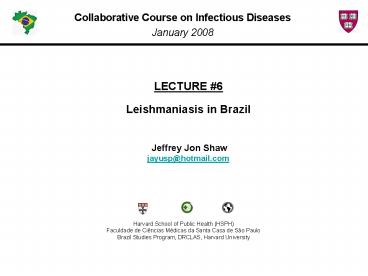SARS Update - PowerPoint PPT Presentation
1 / 19
Title:
SARS Update
Description:
Acute cutaneous disease ulcer or closed lesion at site of sand fly bite. Secondary complications cutaneous metastasis resulting in secondary lesions ... – PowerPoint PPT presentation
Number of Views:72
Avg rating:3.0/5.0
Title: SARS Update
1
Collaborative Course on Infectious
Diseases January 2008
LECTURE 6 Leishmaniasis in Brazil
Jeffrey Jon Shaw jayusp_at_hotmail.com
Harvard School of Public Health (HSPH) Faculdade
de Ciências Médicas da Santa Casa de São Paulo
Brazil Studies Program, DRCLAS, Harvard
University
2
Objectives
- Describe the distribution of leishmaniasis in
Brazil - Describe the transmission cycles of the most
important species - Describe consequences of infection
- Show how changes in the environment are altering
the distribution of the different species found
in man - Discuss the difficulty of controlling the disease
3
Possible lines of discussion
- What is the major epidemiological difference
between leishmaniasis and malaria? - Should leishmaniasis be considered a single
disease entity? - Can visceral leishmaniasis be controlled
- Can cutaneous leishmaniasis be controlled?
- What is the biggest leishmaniasis problem facing
the Brazilian authorities? - Dogs play an important role as reservoirs of
leishmaniasis in various parts of the world
What should be done with them? Should they be
treated? - What are the major epidemiological factors
associated with epidemic visceral leishmaniasis? - What are the potential public health dangers of
so many sub-clinical cases?
4
Leishmaniasis is considered to be endemic in 81
countries
- Most are tropical and subtropical countries
- 60 are classified as developing countries
5
Cutaneous Leishmaniasis
- Number of Cases
- 1 - 1.5 million per year
- Origin
- 90 from Afghanistan, Brazil, Iran, Saudi
Arabia Syria
6
(No Transcript)
7
Regions of high endemicity for cutaneous
leishmaniasis
8
Average density of cases of tegumentary
leishmaniasis, by municipality, Brazil 1994 to
1999 ( cases per Km2 )
Source FUNASA/CENEPI/CGVEP/COVEV
9
Visceral Leishmaniasis
- Number of cases
- 500,000 per year
- Origin
- 90 from Bangladesh,
- India, Nepal, and Sudan
10
(No Transcript)
11
Regions of high endemicity for visceral
leishmaniasis
12
Increase of clinical cases and severe symptoms
related to HIV infections
- 34 countries reporting leishmania / HIV
co-infection worldwide.
13
Vector sand fly (Psychodidae Phlebotominae)
- Different species involved depending on the
species of parasites.
14
Parasite - Two forms
- In the mammalian host intracellular amastigotes
- Spread to uninfected cells of the host after
primary infection - Infective form for the vector
- In the sand fly (vector) extra cellular
promastigotes - Transmitted by the bite of the vector to the
mammalian host
15
Leishmaniasis in Brazil
- Cutaneous disease
- Caused by 8 named species
- In 2006, a total of 22,264 cases were registered
- 20,000 - 35,000 per year during the last 10 years
- The distribution of cases is changing
16
Leishmaniasis in Brazil
- Visceral disease
- Caused by 1 named species
- In 2006 a total of 3,433 cases were registered
- 1,500 - 5,000 per year during the last 10 years
- The disease is becoming endemic in new regions
- The disease is invading urban areas
17
Leishmanial Infections in man
- Incubation after bite (7-14 days)
- Clinical Symptoms
- Asymptomatic
- Acute - visceral disease fever, weight loss,
hepatosplenamegaly - Acute cutaneous disease ulcer or closed lesion
at site of sand fly bite - Secondary complications cutaneous metastasis
resulting in secondary lesions after primary
lesion develops years after cure - mucosal or
disseminated cutaneous lesions
18
Principal Difficulties facing Control Measures in
Brazil
- The different forms of leishmaniasis are zoonosis
controlling infected animal populations is
unfeasible - The breeding sites of the different vectors are
unknown making vector control extremely difficult - The scale of the problem is not matched with the
funds available
19
References
- Grimaldi, G., Jr., David, J.R., MacMahon-Pratt,
D., 1987, Identification and distribution of New
World Leishmania species characterized by
serodeme analysis using monoclonal antibodies.
American Journal of Tropical Medicine and Hygiene
36, 270-287. - Shaw, J.J., Lainson, R., 1987, Ecology and
epidemiology New World, In Peters, W.,
Killick-Kendrick, R. (Eds.) The Leishmaniases in
Biology and Medicine Volume I Biology and
Epidemiology. Academic Press Inc, London, pp.
291-363. - Lainson, R., Shaw, J.J., Silveira, F.T., de
Souza, A.A., Braga, R.R., Ishikawa, E.A., 1994,
The dermal leishmaniases of Brazil, with special
reference to the eco- epidemiology of the disease
in Amazonia. Memórias do Instituto Oswaldo Cruz
89, 435-443. - Shaw, J.J., 1994, Taxonomy of the genus
Leishmania present and future trends and their
implications. Memórias do Instituto Oswaldo Cruz
89, 471-478. - Cupolillo, E., Momen, H., Grimaldi, G., Jr.,
1998, Genetic diversity in natural populations of
New World Leishmania. Memórias do Instituto
Oswaldo Cruz 93, 663-668. - Shaw, J.J., 2002, New World Leishmaniasis the
ecology of leishmaniasis and the diversity of
leishmanial species in Central and South
America., In Farrell, J. (Ed.) World Class
Parasites Leishmania. Kluwer Academic
Publishers, Boston, Dordrecht, London, pp. 11-31.

